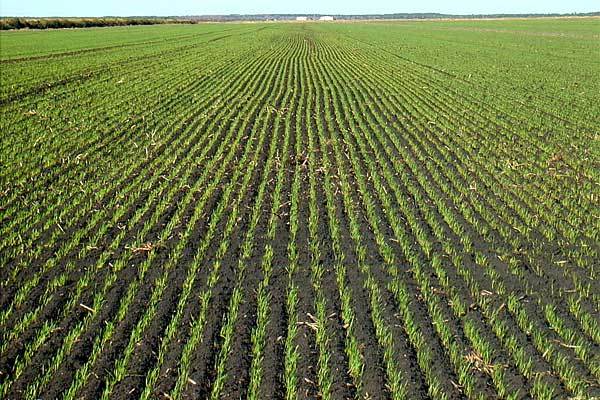
Agricultural News
Oklahoma Wheat Crop Best in The Region According to Latest USDA Crop Progress Report
Mon, 22 Mar 2021 16:33:56 CDT
 Oklahoma's winter wheat crop condition continues to be among the best in the region according to the latest USDA Crop Progress Report.
Oklahoma's winter wheat crop condition continues to be among the best in the region according to the latest USDA Crop Progress Report.
The Oklahoma wheat crop is rated 62 percent good to excellent, 28 percent fair and 10 percent poor to very poor.
Winter wheat jointing reached 36 percent, up 11 points from the previous year and up 5 points from normal.
Canola blooming reached 2 percent, up 2 points from the previous year but down 9 points from normal.
Rye jointing reached 9 percent, down 4 points from the previous year and down 14 points from normal.
Oats jointing reached 6 percent, up 2 points from the previous year but down 5 points from normal.
Pasture and range conditions were rated 29 percent good to excellent, 42 percent fair and 29 percent poor to very poor.
To view the Oklahoma report, click here.
In Kansas, winter wheat conditions are rated 45 percent good to excellent, 34 percent fair and 21 percent poor to very poor.
To view the Kansas report, click here.
In Texas, small grains were reported in various stages and conditions across the state.
In the High Plains, South Texas, and Edwards Plateau, small grains were reported as needing more moisture.
Winter wheat improved as a result of precipitation received earlier in March in the Southern Low Plains.
Meanwhile, winter wheat continued to recover after the winter storm in February in the Cross Timbers and the Blacklands.
Statewide, the Texas winter wheat crop is rated 29 percent good to excellent, 42 percent fair and 29 percent poor to very poor.
Approximately 23 percent of the wheat crop is headed, which is 4 points behind last year but 15 points ahead of the 5-year average.
Texas producers began planting corn and preparing fields to plant sorghum in the Southern High Plains.
Field preparation for planting corn and cotton is underway in the Northern Low Plains.
Fieldwork has begun in preparation for planting sorghum in the Southern Low Plains.
Corn planting continued in the Cross Timbers.
Meanwhile, corn planting has progressed and is close to complete in the Blacklands and South Central Texas.
Corn and sorghum planting continued in Edwards Plateau and South Texas.
Cotton and corn planting neared completion in the Coastal Bend. Rice planting continued in the Upper Coast. Cotton planting was halted due to a lack of moisture in certain areas of the Upper Coast and South Texas. Cotton, corn, and
sorghum planting continued in the Lower Valley.
Statewide, Texas producers have planted 38 percent of their corn crop, 2 points ahead of last year and 4 points ahead of the average for this time of year.
Texas sorghum farmers have planted 34 percent of their crop, 3 points ahead of last year and 6 points ahead of the average.
Farmers began preparing fields to plant watermelons in the Southern High Plains.
Some fruit trees, including peaches, began blooming in the Cross Timbers.
Vegetable crops were doing well in South East Texas.
Sugarcane harvest progressed as vegetable, watermelon, and other summer fruits were being irrigated.
Supplemental feeding continued across the state as spring calving season was wrapping up in the Cross Timbers.
Spring born calves were doing well in areas of the Blacklands and North East Texas.
Feral hogs in hay meadows and pastures continued to be a problem in North East Texas.
Meanwhile, the fly population continued to increase in East Texas.
Hay reserves were low in the Edwards Plateau.
Runoff rainwater was still needed in the Edwards Plateau and South Texas to fill tanks for livestock.
Texas pasture and range conditions are rated 15 percent good to excellent, 33 percent fair and 52 percent poor to very poor.
To view the Texas report, click here.
WebReadyTM Powered by WireReady® NSI
Top Agricultural News
More Headlines...




